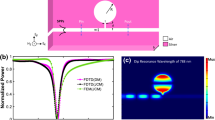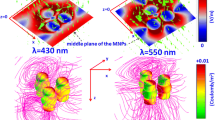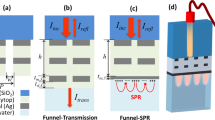Abstract
We study the refractive-index sensing properties of plasmonic nanotubes with a dielectric core and ultrathin metal shell. The few nanometer thin metal shell is described by both the usual Drude model and the nonlocal hydrodynamic model to investigate the effects of nonlocality. We derive an analytical expression for the extinction cross section and show how sensing of the refractive index of the surrounding medium and the figure of merit are affected by the shape and size of the nanotubes. Comparison with other localized surface plasmon resonance sensors reveals that the nanotube exhibits superior sensitivity and comparable figure of merit.



Similar content being viewed by others
References
Anker JN, Hall WP, Lyandres O, Shah NC, Zhao J, van Duyne RP (2008) Nat Mater 7:442
Prodan E, Radloff C, Halas NJ, Nordlander P (2003) Science 302:419
Brongersma ML (2003) Nat Mater 2:296
Raschke G, Brogl S, Susha AS, Rogach AL, Klar TA, Feldmann J, Fieres B, Petkov N, Bein T, Nichtl A, Kürzinger K (2004) Nano Lett 4:1853
Nehl CL, Grady NK, Goodrich GP, Tam F, Halas NJ, Hafner JH (2004) Nano Lett 4:2355
Tam F, Moran C, Halas NJ (2004) J Phys Chem B 108:17290
Bardhan R, Lal S, Joshi A, Halas NJ (2011) Acc Chem Res 44:936
Prodan E, Nordlander P (2004) J Chem Phys 120:5444
David C, García de Abajo FJ (2011) J Phys Chem C 115:19470
Toscano G, Raza S, Jauho A-P, Mortensen NA, Wubs M (2012) Opt Express 20:4176
Boardman AD, Paranjape BV (1977) J Phys F: Met Phys 7:1935
Dasgupta BB, Fuchs R (1981) Phys Rev B 24:554
Ruppin R (1973) Phys Rev Lett 31:1434
Raza S, Toscano G, Jauho A-P, Wubs M, Mortensen NA (2011) Phys Rev B 84:121412(R)
Jones WE, Kliewer KL, Fuchs R (1969) Phys Rev 178:1201
McPhillips J, Murphy A, Jonsson MP, Hendren WR, Atkinson R, Höök F, Zayats AV, Pollard RJ (2010) ACS Nano 4:2210
Lim MA, Kim DH, Park CO, Lee YW, Han SW, Li Z, Williams RS, Park I (2012) ACS Nano 6:598
Schröter U, Dereux A (2001) Phys Rev B 64:125420
Zhu J, Li KF (2011) Eur Phys J B 80:83
Rakić AD, Djurišić AB, Elazar JM, Majewski ML (1998) Appl Opt 37:5271
Fuchs R, Claro F (1987) Phys Rev B 35:3722
Mayer KM, Hafner JH (2011) Chem Rev 111:3828
Mahmoud MA, El-Sayed MA (2010) J Am Chem Soc 132:12704
Jeppesen C, Xiao S, Mortensen NA, Kristensen A (2010) Opt Express 18:25075
Ruppin R (2001) Opt Commun 190:205
Zuloaga J, Prodan E, Nordlander P (2009) Nano Lett 9:887
Öztürk ZF, Xiao S, Yan M, Wubs M, Jauho A-P, Mortensen NA (2011) J Nanophotonics 5:051602
van de Hulst H (1957) Light scattering by small particles. Wiley, New York
Author information
Authors and Affiliations
Corresponding author
Appendix
Appendix
The nonlocal optical properties of the nanotube are determined by solving Maxwell’s wave equation coupled to the hydrodynamic equation for the current [14]. We solve the coupled set of equations by extending the Mie theory for wires of Ref. [25] to core–shell structures. By expanding the electromagnetic fields in the dielectric core, metal shell, and surrounding medium in cylindrical Bessel functions, we can most easily take into account Maxwell’s boundary conditions along with the additional boundary condition of a vanishing normal component of the current in the nonlocal case [14]. Although quantum tunneling is not taken into account with this treatment, we do not expect any such effects to be important in this structure [26, 27].
To determine the extinction property of the infinite cylindrical nanotube we calculate the extinction cross section [28]
where \(k_0=\sqrt{\epsilon_\text{b}} \omega/c\) is the background wave vector, \(\epsilon_\text{b}\) is the background permittivity, and a n is a cylindrical Bessel-function expansion coefficient for the scattered electromagnetic field. We consider a normally incident electric-field polarization perpendicular to the cylinder axis (TM), as sketched in the inset of Fig. 1. The nonlocal-response scattering coefficient is calculated analytically as
Here, J n and H n are the Bessel and Hankel functions of the first kind, \(k_\text{t} = \sqrt{\epsilon} \omega/c\), and \(\epsilon(\omega)=\epsilon_\text{other}(\omega) - \omega_\text{p}^2/(\omega[\omega+i\gamma])\) is the Drude local-response function that includes interband effects through \(\epsilon_\text{other}(\omega)\). The arguments of the Bessel and Hankel functions are \(k_\text{t} r_2\) unless written explicitly otherwise.
The coefficients P n , Q n , and C n are given by
where \(k_\text{c} = \sqrt{\epsilon_\text{c}} \omega/c\) and \(\epsilon_\text{c}\) is the dielectric constant of the core. Furthermore, \(k_\text{l}^2=(\omega^2+i\omega\gamma-\omega_\text{p}^2/\epsilon_\text{other})/\beta^2\) and \(\beta^2=3 v_\text{F}^2/5\) with \(v_\text{F}\) being the Fermi velocity of the metal shell. The coefficients p n , q n , α n , δ n and τ n of Eqs. (4–5) are given as
while the coefficients c n and d n of Eq. (6) are given as
where
The local-response result can be retrieved in the limit of a vanishing Fermi velocity for which P n = p n , Q n = q n , and C n = 0.
Rights and permissions
About this article
Cite this article
Raza, S., Toscano, G., Jauho, AP. et al. Refractive-Index Sensing with Ultrathin Plasmonic Nanotubes. Plasmonics 8, 193–199 (2013). https://doi.org/10.1007/s11468-012-9375-z
Received:
Accepted:
Published:
Issue Date:
DOI: https://doi.org/10.1007/s11468-012-9375-z




